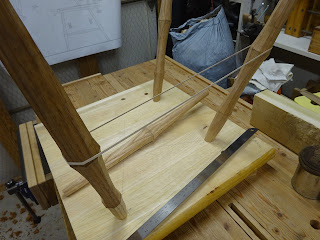Last post I had dry-fitted the undercarriage and completed shaping the seat. When I went to glue up the legs and seat, I found some stretcher tenons (cylindrical) were a bit too small. Not sure if they continued to shrink or what, but I had to glue on some shavings to make them fit better.
 |
| The clamping method for gluing shavings to the tenon |
 |
| A patched tenon |
 |
| The undercarriage and seat glued up ... |
 |
| ... but there was a problem. |
 |
| This crack goes all the way back to the rear leg |
Apparently I was a bit too aggressive when pounding this together. Gotta watch out for those tapered conical mortises and tenons - by definition they are a wedge. I forced some glue into the crack from both top and bottom and clamped it. So far it's holding fine. If I think I need to, I could add a bow-tie inlay across the crack on the seat bottom.
 |
| After cleaning up the squeeze-out, can't even notice the crack |
The next task was getting the posts, crest rail and spindles glued up. I didn't get any pictures of boring the holes in the crest rail or in the seat, but that went well and the glue-up wasn't too stressful. The joints are wedged with white oak.
 |
| Gluing up the chair back |
 |
| A post and it's wedge sticking out the bottom of the seat |
 |
| After the glue dried, the protruding wedged joints were domed with a gouge or chisel |
The last real challenge was fitting the arms. Much earlier I had shaped the arm supports and bored and tapered holes in the seat for the arm supports. In Curtis' video series on these chairs, he made a side chair with no arms, so I was left to my own devices to figure out how to install the arms.
There were two things needed to happen. First, bore a hole in the post for the back of the arm to fit into. At the correct angle. And second, bore and taper a hole in the arms to fit on the arm supports. At the proper angle.
The second task should have been straight forward, given that the resultant and sightline angles were given on the plan. But things don't always go as planned. Fortunately I made a test arm first to iron out the details.
First things first: boring the hole in the post.
 |
In this pic, my thumb is touching the post. The arm support is at lower right.
To get the "left-right" angle, stretching a rubber band between the two centers of the
post and arm support and lining up a ruler on the seat to draw a line parallel to the rubber band
(it was actually a little different from that - something more accurate) |
 |
To get the "up-down" angle for boring the post, getting a distance from the seat to
where the middle of the arm will be on the arm support ... |
 |
| ... then using that same distance to locate the boring bit (where the arm support would be) |
 |
| Another picture of that setup |
This worked well for boring the short hole in the post for the stub tenon. Then I bored the rest of the way through the post with a smaller bit (at that same angle).
Boring and tapering the hole in the arm was key to success. if the tapered hole is not at the right angle, the arm's tenon will not line up with the hole bored in the post. To get this right, I'd need to taper the hole in the arm only slightly, check the angle on the chair, taper some more, check again and repeat until the proper depth of taper was achieved while making sure the arm's stub tenon pointed at the hole in the post.
 |
Before boring the hole in the post, checking where to start the arm's tenon
|
 |
And also seeing if the arm is at the right angle to fit into the post.
Here, the back of the arm is just a little too high - the post hole will be centered on the bulge |
It took another step of adjusting the taper in the hole in the arm to get it right. But it came out right. Well, almost - for some reason the top of the arm shown above is not quite flat: it slants to the outside a bit. I don't notice it when sitting in the chair, so it's not a worry.
One detail of the arm attachment is that a hole is drilled into the back of the arm through the stub tenon. Remember that the hole bored in the post was done in two steps: first a shallow hole for the stub tenon, then a narrower hole all the way through. The through hole allowed me to drill back through the post through the stub tenon and into the back of the arm. A dowel (loose tenon) is glued in from the back to lock the arm to the post.
 |
Here's one of the arm assemblies gluing up.
Note the wedges at top and bottom of arm support and also at back of post. |
And ......... we're done!
 |
| Glamour shot - finally complete |
 |
Well, the last instruction on the plans says to sit in the chair.
Who am I to argue? |
And just to give credit where credit is due, I added a note where I signed the piece (underside of seat on the bevel).
 |
| Thanks, Curtis |
Currently, I'm not planning to add any kind of finish to the chair. I could change my mind on that later, but for now I like it how it is.







































